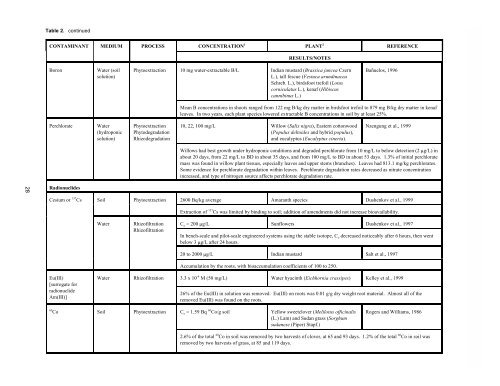Ground Water Issue Phytoremediation of Contaminated ... - CLU-IN
Ground Water Issue Phytoremediation of Contaminated ... - CLU-IN
Ground Water Issue Phytoremediation of Contaminated ... - CLU-IN
Create successful ePaper yourself
Turn your PDF publications into a flip-book with our unique Google optimized e-Paper software.
28<br />
Table 2. continued<br />
CONTAM<strong>IN</strong>ANT MEDIUM PROCESS CONCENTRATION 1<br />
Boron <strong>Water</strong> (soil<br />
solution)<br />
Perchlorate <strong>Water</strong><br />
(hydroponic<br />
solution)<br />
Radionuclides<br />
PLANT 2<br />
RESULTS/NOTES<br />
Phytoextraction 10 mg water-extractable B/L Indian mustard (Brassica juncea Czern<br />
L.), tall fescue (Festuca arundinacea<br />
Schreb. L.), birdsfoot trefoil (Lotus<br />
corniculatus L.), kenaf (Hibiscus<br />
cannibinus L.)<br />
Phytoextraction<br />
Phytodegradation<br />
Rhizodegradation<br />
Bañuelos, 1996<br />
REFERENCE<br />
Mean B concentrations in shoots ranged from 122 mg B/kg dry matter in birdsfoot trefoil to 879 mg B/kg dry matter in kenaf<br />
leaves. In two years, each plant species lowered extractable B concentrations in soil by at least 25%.<br />
10, 22, 100 mg/L Willow (Salix nigra), Eastern cottonwood<br />
(Populus deltoides and hybrid populus),<br />
and eucalyptus (Eucalyptus cineria).<br />
Nzengung et al., 1999<br />
Willows had best growth under hydroponic conditions and degraded perchlorate from 10 mg/L to below detection (2 g/L) in<br />
about 20 days, from 22 mg/L to BD in about 35 days, and from 100 mg/L to BD in about 53 days. 1.3% <strong>of</strong> initial perchlorate<br />
mass was found in willow plant tissues, especially leaves and upper stems (branches). Leaves had 813.1 mg/kg perchlorates.<br />
Some evidence for perchlorate degradation within leaves. Perchlorate degradation rates decreased as nitrate concentration<br />
increased, and type <strong>of</strong> nitrogen source affects perchlorate degradation rate.<br />
Cesium or 137 Cs Soil Phytoextraction 2600 Bq/kg average Amaranth species Dushenkov et al., 1999<br />
Eu(III)<br />
[surrogate for<br />
radionuclide<br />
Am(III)]<br />
<strong>Water</strong> Rhiz<strong>of</strong>iltration<br />
Rhiz<strong>of</strong>iltration<br />
Extraction <strong>of</strong> 137 Cs was limited by binding to soil; addition <strong>of</strong> amendments did not increase bioavailability.<br />
C o = 200 g/L Sunflowers Dushenkov et al., 1997<br />
In bench-scale and pilot-scale engineered systems using the stable isotope, C o decreased noticeably after 6 hours, then went<br />
below 3 g/L after 24 hours.<br />
20 to 2000 g/L Indian mustard Salt et al., 1997<br />
Accumulation by the roots, with bioaccumulation coefficients <strong>of</strong> 100 to 250.<br />
<strong>Water</strong> Rhiz<strong>of</strong>iltration 3.3 x 10 -4 M (50 mg/L) <strong>Water</strong> hyacinth (Eichhornia crassipes) Kelley et al., 1999<br />
26% <strong>of</strong> the Eu(III) in solution was removed. Eu(III) on roots was 0.01 g/g dry weight root material. Almost all <strong>of</strong> the<br />
removed Eu(III) was found on the roots.<br />
60 Co Soil Phytoextraction Co = 1.59 Bq 60 Co/g soil Yellow sweetclover (Melilotus <strong>of</strong>ficinalis<br />
(L.) Lam) and Sudan grass (Sorghum<br />
sudanese (Piper) Stapf.)<br />
Rogers and Williams, 1986<br />
2.6% <strong>of</strong> the total 60 Co in soil was removed by two harvests <strong>of</strong> clover, at 65 and 93 days. 1.2% <strong>of</strong> the total 60 Co in soil was<br />
removed by two harvests <strong>of</strong> grass, at 85 and 119 days.
















